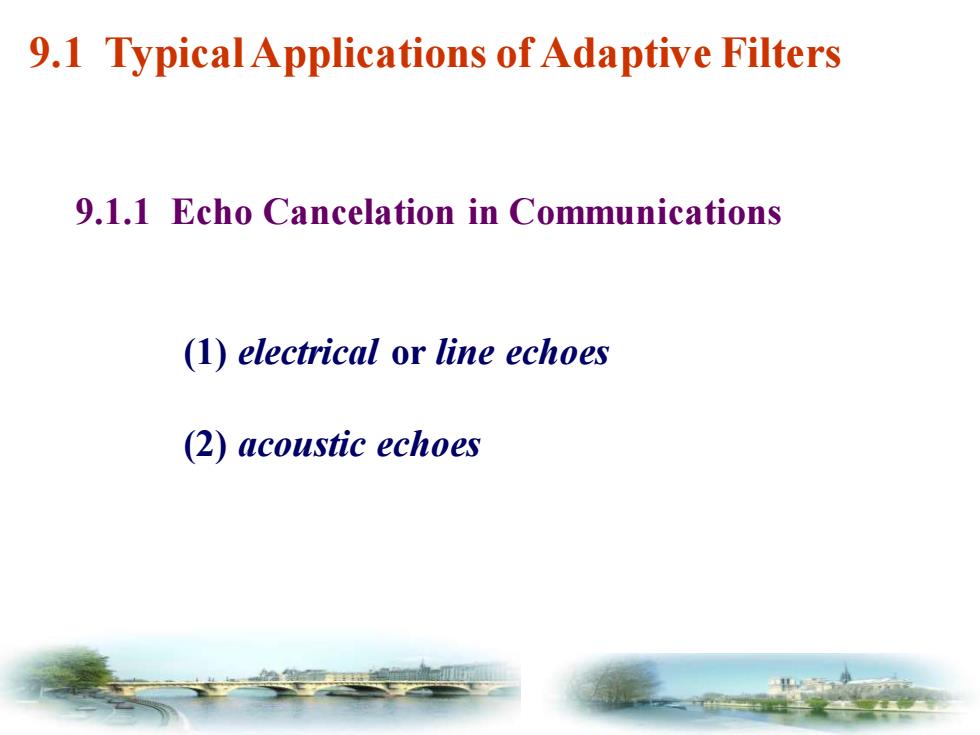
CHAPTER 9 Adaptive Filters Goal of an adaptive filter: To "find and track"the optimum filter obtained by using the knowledge of signal statistics. Why to find?How to track?
CHAPTER 9 Adaptive Filters Goal of an adaptive filter: To “find and track” the optimum filter obtained by using the knowledge of signal statistics. Why to find? How to track?

Contents 9.1 Typical Applications of Adaptive Filters 9.2 Principles of Adaptive Filters 9.3 Method of Steepest Descent 9.4 Least-Mean-Square Adaptive Filters 9.5 Recursive Least-Squares Adaptive Filters 9.6 Fast RLS Algorithms for FIR Filtering 9.7 Tracking Performance of Adaptive Algorithms 9.8 Summary
9.1 Typical Applications of Adaptive Filters 9.2 Principles of Adaptive Filters 9.3 Method of Steepest Descent 9.4 Least-Mean-Square Adaptive Filters 9.5 Recursive Least-Squares Adaptive Filters 9.6 Fast RLS Algorithms for FIR Filtering 9.7 Tracking Performance of Adaptive Algorithms 9.8 Summary Contents

9.1 Typical Applications of Adaptive Filters 9.1.1 Echo Cancelation in Communications (1)electrical or line echoes (2)acoustic echoes
(1) electrical or line echoes (2) acoustic echoes 9.1.1 Echo Cancelation in Communications 9.1 Typical Applications of Adaptive Filters

9.1.1 Echo Cancelation in Communications Four-wire connection Two-wire connection Speech from Hybrid Hybrid A B Talker Echo of 4's Talker A speech Speech B from B FIGURE 9.1 Echo generation in a long-distance telephone network
FIGURE 9.1 Echo generation in a long-distance telephone network 9.1.1 Echo Cancelation in Communications

9.1.1 Echo Cancellation in Communications The switch remains off when talker B is silent! Echo suppressor 声控开关 Control Hybrid Talker Speech B from B What if talkers A and B quarrel with each other? Voice clipping will happen! FIGURE 9.2 Principle of echo suppression
FIGURE 9.2 Principle of echo suppression 9.1.1 Echo Cancellation in Communications 声控开关 The switch remains off when talker B is silent! What if talkers A and B quarrel with each other? Voice clipping will happen!

9.1.1 Echo Cancelation in Communications Two Possible Ways 1.Design a compromise fired echo canceler based on some “average'”echo path(平均的抵消回声). 2.Design an adaptive echo canceler that can "learn"the echo path when it is first turned on and afterward "tracks"its variations without any intervention from the designer 应的抵消回声)·
Two Possible Ways 1. Design a compromise fixed echo canceler based on some “average” echo path(平均的抵消回声). 2. Design an adaptive echo canceler that can “learn” the echo path when it is first turned on and afterward “tracks” its variations without any intervention from the designer(自适 应的抵消回声). 9.1.1 Echo Cancelation in Communications

9.1.1 Echo Cancelation in Communications Echo canceler From talker A Hybrid B Speech Talker Echo from B B To talker A replica D Echo from 4 The adaptive filter attempts to estimate the path from C to D and then generate an echo replica for noise cancellation. In this way,the talkers can quarrel if they want t0. FIGURE 9.3 Principle of echo cancelation
9.1.1 Echo Cancelation in Communications FIGURE 9.3 Principle of echo cancelation The adaptive filter attempts to estimate the path from C to D and then generate an echo replica for noise cancellation. In this way, the talkers can quarrel if they want to

9.1.3 Noise Cancelation What is the practical scenario for such a noise cancellation paradigm? 1)KARAOKE Bar. 2)Noise-cancellation Headphone Signal s(n)+(n) e(n) source Primary input Noise 2物 Filter source Reference input FIGURE9.6 Principle of adaptive noise cancellation using a reference input
FIGURE 9.6 Principle of adaptive noise cancellation using a reference input. 9.1.3 Noise Cancelation What is the practical scenario for such a noise cancellation paradigm? 1) KARAOKE Bar. 2) Noise-cancellation Headphone

9.1.3 Noise Cancelation Signal s(n)+(n) e(n source Primary input Noise (倒 Filter source Reference input The signals s(n),v(n),and v2(n)are jointly wide-sense stationary with zero mean values.The"clean"signal is given by the error e(n)=s(n)+[y(n)-n)] where (n)depends on the filter structure and parameters
The signals and are jointly wide-sense stationary with zero mean values. The “clean” signal is given by the error s n v n ( ) ( ) 1 v n 2 ( ) where depends on the filter structure and parameters. y n ˆ( ) 9.1.3 Noise Cancelation

9.1.3 Noise Cancelation Signal (m)+y1(m) e(n) source Primary input Noise 2(例 Filter source Reference input The MSE is given by Ede(n)=Es(n)+Ev(n)-(n
The MSE is given by 9.1.3 Noise Cancelation